With a stunning coastline on the Adriatic Sea, many cities in Croatia are located along the coast and combine beach life with culture. Although the winters can be cold, the summers in Croatia are very warm and the country has, on average, 2,500 hours of sun every year. Croatia has a rich history going back thousands of years, and you can see evidence in many Croatian cities.
Split, for example, started to develop around 305 AD, and you can visit Diocletian’s Palace, which is a UNESCO World Heritage Site. He was a Roman Emperor during the Roman occupation and his palace is virtually intact, giving you a good idea of the life of the rich and powerful centuries ago.
The coastal cities of Dubrovnik and Zadar are famous for their historic city centres and beautiful beaches. Inland, you will find Zagreb, the capital of Croatia, with its beautiful 18th and 19th-century architecture, harking back to when it belonged to the Austro-Hungartian Empire. These cities are gateways to the islands (over 1,200 islands), some no more than a rock, others bustling with life.
Croatian cuisine is affordable, all about fresh and seasonal ingredients, traditional food and ancient recipes. You will find plenty of freshly caught grilled fish and seafood in the coastal cities of Croatia. Further inland, you will be offered more meat dishes and casseroles. There are vegetarian restaurants in the cities, but vegan is a little harder to source, except in Zagreb. Here are the cities in Croatia to visit, whether you’re looking for beach life or culture or both.
Contents
Cities in Croatia
Top Tours
- Zagreb Sightseeing Walking Tour – ride the funicular too!
- Dubrovnik: Old Town Walking Tour – explore with a local.
- From Split: Krka Waterfalls, Food & Wine Tasting Tour – for stunning scenery and lovely food.
20 Croatian Cities
1- Zagreb
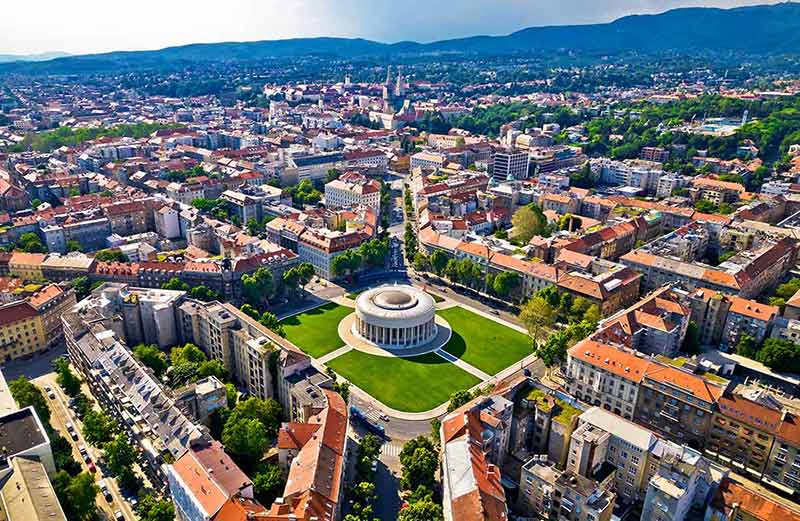
Zagreb, the capital of Croatia, is the largest city in Croatia and is often overlooked as many tourists tend to head towards the seaside resorts.
I recommend visiting the city if you like history, beautiful architecture from different periods and many museums.
Most of the attractions in Zagreb are located around the city centre and are best explored on foot.
Take a taxi or public transport to visit sites like the Mirogoj Cemetery. The tram and bus services are efficient and frequent.
The Upper Town is the city’s oldest part and dates back to the 11th century, showing off its history with narrow streets, cobbled pathways, and small houses.
To reach it from the Lower Town, the new town, the funicular, is one of the shortest in the world, covering a distance of 66 metres (216.5 feet).
However, if you decide to walk up the steps instead, be warned that it is a steep climb.
In the Upper Town, you will find many old buildings, such as the beautiful cathedral dating back to the 13th century, which was rebuilt after the 1880 earthquake destroyed it.
The Lower Town is more modern and was created in the late 19th century, where you will see some spectacular houses built in the Art Nouveau style.
These homes are much bigger than the ones found in the Upper Town.
The Lower Town is Zagreb’s cultural, shopping and business area.
There are many shops to be found here, as well as restaurants, cafes and museums.
An interesting museum to visit is the Mim`ara Museum, which houses 3,750 artefacts from ancient Greece and Rome.
There are original paintings by Rembrandt, Manet, Renoir, and Rubens.
To get a taste of local life, head to Dolac Market in the centre of the city even if you don’t intend to buy anything.
It is a farmer’s market and has a lively atmosphere.
The colours of the fruit and vegetables are vibrant, and the smells are delicious.
It is worth taking the bus to the Mirogoj Cemetery, one of Europe’s most beautiful cemeteries.
Established in the 19th century, many famous Croatians are buried in richly decorated tombs.
It’s owned by the city and not by any particular religious denomination, so all religious groups are buried here.
To get spectacular city views, climb to the top of the Zagreb 360-Degree Observation Deck.
Zagreb has one of the most unusual museums I have ever heard of.
It’s in the Upper Town and is called The Museum of Broken Relationships, which has personal items and stories about past relationships from people around the world.
It is worth visiting, if just for the novelty.
If you long for a bit of nature, there are plenty of green spaces in Zagreb and the lovely Botanical Gardens is a place to wander for a few hours.
It has a fantastic number of over 10,000 plant species.
- The Mimara Museum is at Rooseveltov trg 5 10000
- The Mirogoj Cemetery is at Aleja Hermanna Bollea 27 10000
- The Museum of Broken Relationships is at Cirilometed ska ul 2 10000
- Zagreb sightseeing walking tour with the funicular
- The Hop On Hop Off Bus
2- Dubrovnik
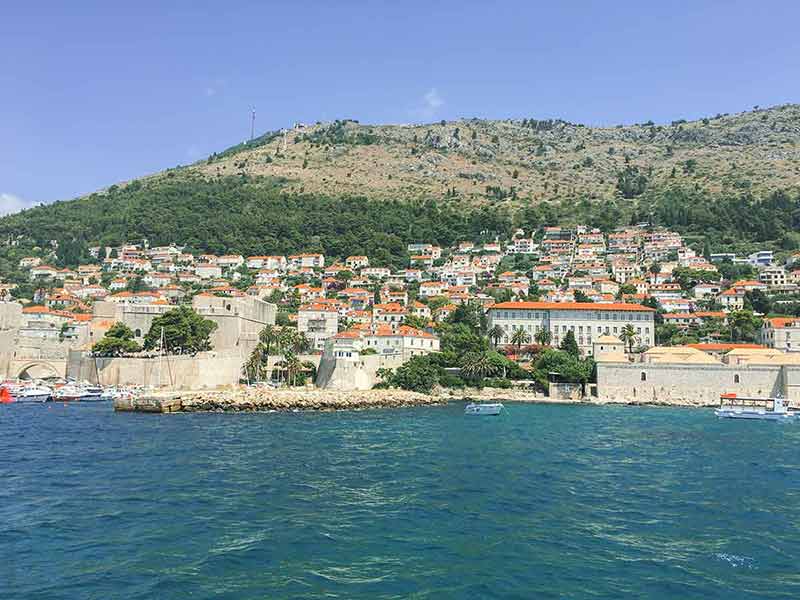
At the top of the list of coastal cities in southern Croatia is Dubrovnik and many visitors flock to swim in the city’s warm, clear waters.
Dubrovnik’s charming Old Town is surrounded by massive stone walls built in the 15th century and is made of limestone.
You should walk along the walls as you will get spectacular views of the city and of the Adriatic Sea.
Visit St John’s Fortress, which is part of the city walls where, on the first floor, there is a small aquarium and on the upper floor, a Maritime Museum.
The Old Town is unusual because all the houses have the same floor plan due to a city decree following a fire and earthquake in the 17th century.
The Baroque City Cathedral is worth visiting and it’s also worth joining a walking tour.
You will find many artworks and liturgical items dating from the 11th to 18th centuries.
If you crave nature after a busy couple of sightseeing days, the Trsteno Arboretum is a beautiful park on a hill by the sea.
The 15th-century landmark has beautiful sculptures, fountains, and an aqueduct irrigating the park.
The highlight is a pair of oriental plane trees that are 500 years old.
The traditional dish of Dubrovnik is black risotto, made with cuttlefish with black ink and mussels and clams added.
The City Cathedral is at ul Kneza Damjana Jude 1 20000. Game of Thrones fans may want to check out this tour.
3- Zadar
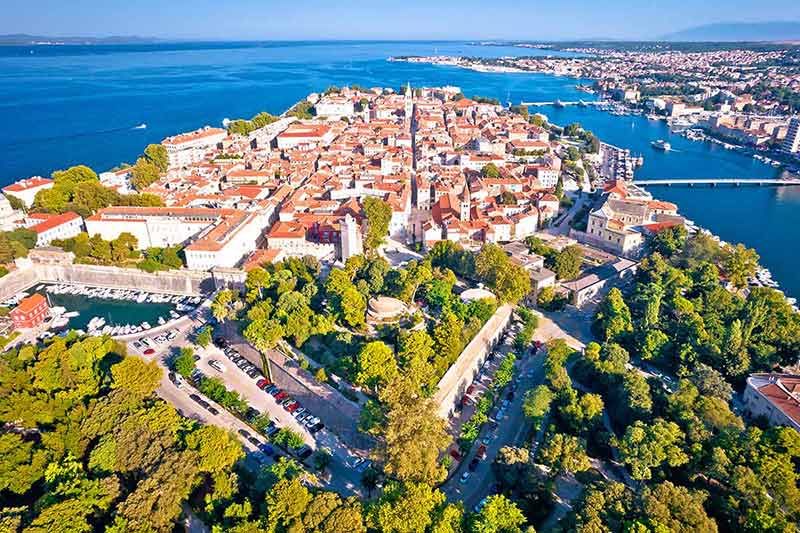
Zadar is a city on the coast known for its Roman and Venetian ruins.
The Old Town is lovely with cobbled streets so wear sensible shoes.
The streets are narrow, and you will come across both Mediaeval and Roman churches.
The 9th-century Church of St. Donatus sits on ancient Roman ruins and part of the church floor has been removed to showcase the original stonework below.
Stones used to build the church were taken from the Roman Forum between the 1st and 3rd centuries.
It is worth visiting the Forum at night as it is lit up.
There are remains of the foundations of buildings at the Forum, paving stones, and a Corinthian column.
Zadar Cathedral is a mixture of Byzantine architecture from the 9th century and Romanesque from the 13th century.
You can climb the Bell Tower for spectacular views of the city.
Two highlights of Zadar are to be found on the seafront.
The Sea Organ is an enormous musical instrument played by the waves, and close by is the Greeting to the Sun with its 300 multi-layered glass plates that light up at night.
The main city beach is Kolovare Beach.
The water here is crystal-clear, and it’s a top spot to spend the day, especially as there’s a pick of restaurants nearby.
- The Church of Dondus is at Trg Rimskeg Foruma 23000
- Zadar Cathedral is at Trg Svete Stasije 23000
- The Sea Organ and Greeting to the Sun are at Obala Kralja Petra Kresimira 11 23000
- Zadar Private Walking Tour – through 300 years of history
- Zadar Walking Tour – with Maraschino and Pag Cheese Tasting
- Zadar: Museum of Illusions Entrance Ticket
4- Rijeka
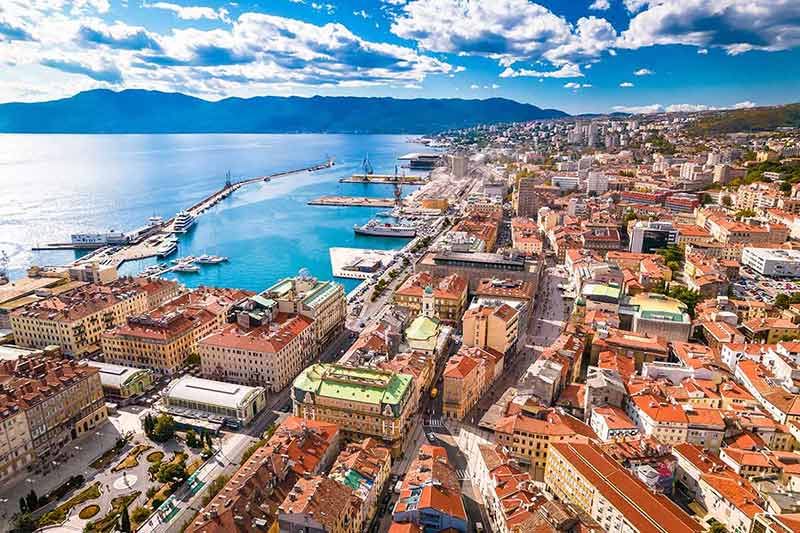
Rijeka is a port city on Kvamer Bay in the country’s north.
From here, you can travel to many of Croatia’s islands, and it’s great to relax on a beach or swim in the sea, as there are some Blue Flag beaches here.
Sabilicevo Beach has emerald-coloured waters, which are lovely and warm in the summer.
The Old Town has a neo-classical building, and if it’s not too hot, climb the 538 steep steps leading to the Church of Our Lady of Trust.
The steps are part of a pilgrimage path to the church, and there are little chapels where you can pray or rest.
The church was built in 1291 and houses religious treasures.
At the top of the stairs is the 13th-century Trsat Castle, built on top of a Roman Fort offering views of the town, sea and the Rjecina River.
- The Church of Our Lady of Trust is at Frankopanski trg 51000
- Trsat Castle is at Partizanski put 9a 51000
5- Split
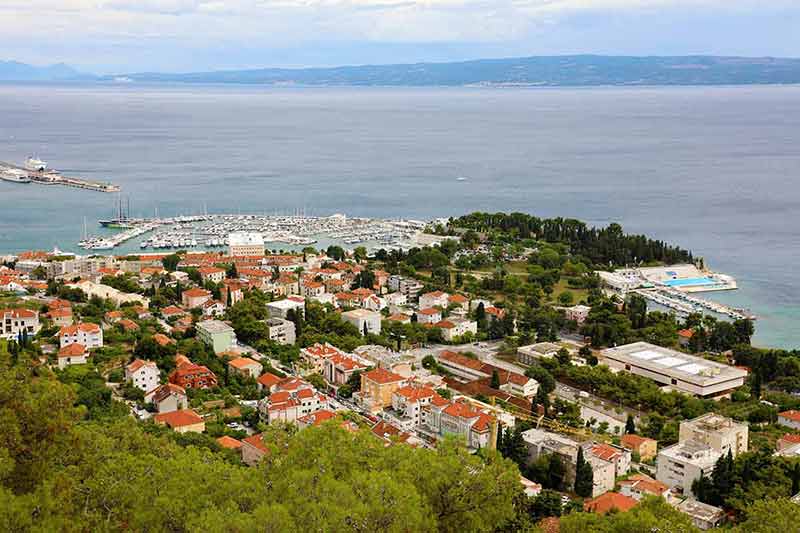
Split is on the Adriatic coast, situated on a central peninsula and surrounding area.
As in most Croatian cities, the Old Town is worth visiting, and Split’s is a UNESCO World Heritage Site.
You will find the Roman Emperor, Diocletian’s Palace, which has the remains of a military camp, the Golden Gate, and Diocletian’s retirement villa.
There are many squares in Split’s old town to relax with a coffee or beer.
In Fruit Square, you will find traditional markets to buy souvenirs.
Pjaca Square is upmarket with marble tiles and sophisticated cafes, while Marmot Square is the place to mingle with the locals.
It is by the seafront and has many shops, cafes, and restaurants.
Peristil Square was once a Roman court. It is well-preserved and has two spectacular 3,500-year-old sphinxes in all their splendour.
Split Cathedral, in the old town, was once Diocletian’s mausoleum. It was built in 350 AD, and some Roman elements have been maintained.
Next to it is the Bell Tower, which you can climb for magnificent city views.
Of course, as Split is by the sea, there are some lovely beaches here, many near the pine woodlands of the Marjan Hills.
- Diocletian’s Palace is at Dioklecijanova 1 21000
- The Cathedral is at ul Krey Svetog Duje 3 21000
- Split Walking Tour
- From Split: Krka Waterfalls, Food & Wine Tasting Tour
6- Pula
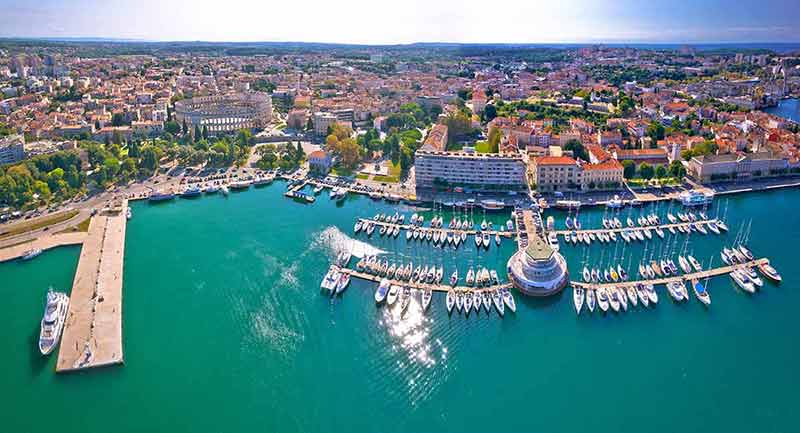
Pula is a city on the seafront on the tip of Croatia’s Istrian peninsula.
It isn’t as touristy as Dubrovnik, but this is beginning to change as people discover how lovely the beaches are and that the city has a rich history to explore.
Pula is famous for its Roman ruins and the Colosseum is in the city centre.
It’s not as big as the Colosseum in Rome, but it is still impressive, especially as it is virtually intact.
Built in the 1st century and used for entertainment in the 6th century, it’s still used for performances such as gladiator battles and plays.
You might be lucky enough to be in Pula when there is entertainment in the Colosseum. Skip the line and book your arena entrance tickets here.
The land around Pula is perfect for making wine and produces some excellent wine, so if you enjoy a glass or two, why don’t you visit a winery?
The Trapan Winery, just outside the city, is one of the best wineries in Pula.
They produce wines unique to Croatia, such as Malvasia, a white wine, and the red Teran.
When it comes to local food, fresh fish is at the top of the menu at many of the seafront restaurants.
Truffles are often used in cooking, and most food is cooked in olive oil.
Also read:
- 21 Landmarks In Croatia
- 25 Things To Do In Croatia
- When Is The Best Time To Visit Croatia?
- 20 Best Beaches In Croatia
- 20 Things To Do In Zagreb
- 23 Filming Locations For Game of Thrones in Croatia
- 20 Things To Do In Split
- 20 Things To Do In Dubrovnik
- 20 Islands In Croatia
- 20 Ways To Celebrate Christmas In Croatia
- 20 Things To Do In Zadar
- 20 Things To Do In Pula
- 20 Day Trips From Dubrovnik
- 20 Things To Do In Sibenik
- 25 Types of Croatian Food
- Where To Stay In Dubrovnik
- 20 Croatian Cities For Your Bucket List
- 15 Things Croatia Is Famous For
7- Sibenik
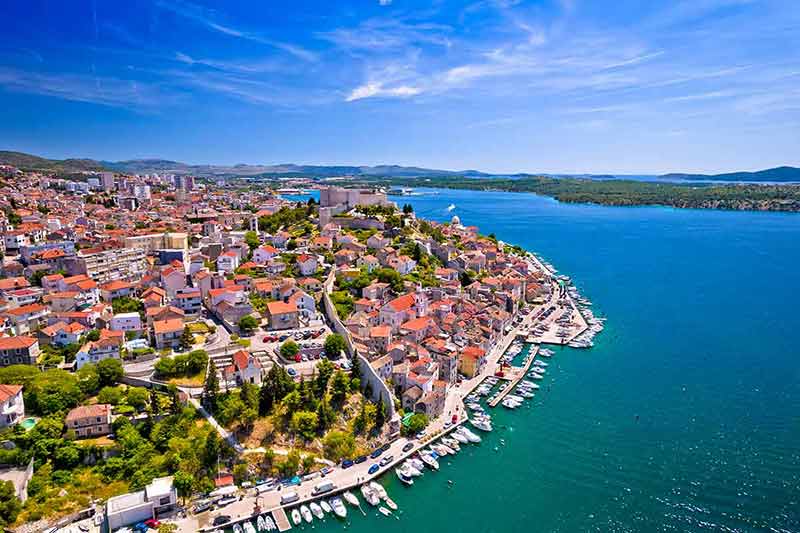
Sibenik is on the Adriatic coast, from where you can get a ferry to the Kornati Islands.
There are several beaches here, and the promenade is lovely, with popular cafes, restaurants, and bars.
The highlight of Sibenik is the Cathedral of Saint James.
It was built between 1431 and 1536, and you will see both Gothic and Renaissance styles outside and inside the cathedral.
It is a triple-nave Catholic Basilica with three apses and a dome.
On the outside are 71 sculpted heads of residents of Sibenik who lived when the cathedral was being constructed.
Inside, there are paintings and Baroque decorations.
Buying a ticket to the cathedral also covers the entrance to the Interpretation Ventre of Saint James-Galbiani Palace, which has an interactive museum.
Sibenik has four fortresses, but if you only have time for one, choose St. Michaels for the fantastic views of the city, well-maintained walkways and a cafe to relax after a busy day’s sightseeing.
The Cathedral of Saint James is at Trg Republike Hrvatske 3 22000. You may like this guided evening walk.
8- Osijek
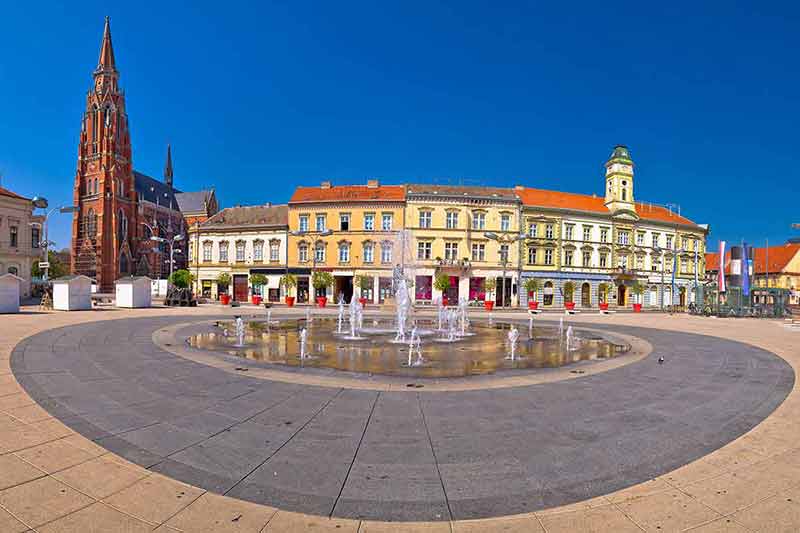
Osijek is the fourth-largest city in Croatia and is on the right side of the Drava River in eastern Croatia.
Life in Osijek centres around the main square, the Trg Ante Starcevica square, where you will find shops and cafes.
Next to the square is the Church of St. Peter and St. Paul, 94 metres (308 feet) high.
It has been built in Neo-Gothic style and has some beautiful stained-glass windows.
The Old Town is a jewel box of Baroque buildings and the Habsburg Star Fort, built in 1687.
The inside of the fort has been converted to house the best nightlife centre in the city.
You will find clubs and bars here, as well as restaurants.
Stroll by the Drava River and look for restaurants and bars along the promenade to relax.
Copacabana River Beach is popular in the summer.
You can swim here and sunbathe and there are public pools right next to the beach.
Across the bridge from here is the Osijek Zoo & Aquarium, the biggest zoo in the country.
Osijek has plenty of nature spots to escape the buzz of the city.
There are 17 parks, the biggest being Kapacki Park, the largest wetland in Europe.
Try local dishes such as river fish, culen (sausage), slanina and fis paprikas (fish soup with paprika).
The Church of St. Peter & St. Paul is at Trg Papelvana Pavla 11 23000.
9- Varazdin
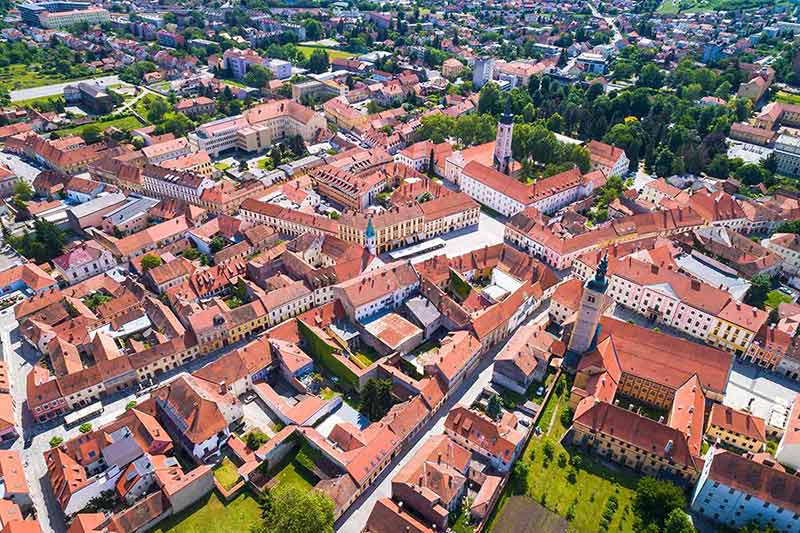
Varazdin is another city on the Drava River in northeast Croatia, close to Zagreb.
It has beautiful Baroque and Rococo architecture.
The city has a spectacular castle called Stari Grad, which means Old Town.
In the past, the castle contained the whole town within its walls.
The stone structure was built in the 12th century but in the 16th century, a moat and drawbridge were added.
The castle is in excellent condition and now houses the Varazdin City Museum.
The Sermage Palace is has a striking Rococo facade and is worth visiting as it now has an art museum with both old and contemporary paintings.
The main square, King Tomislav Square, is a great place to hang out as you’ll find cafes, restaurants and shops, the Varazdin Cathedral, the Town Hall, and some museums.
The Museum of Angels is lovely and houses motif paintings of angels by Zeljko Prstec.
- The castle is at Setaliste Josipa Jurga Strossmayera 1 42000
- The Sermage Palace is at Trg Milijenka Stanica 2 42000
- The Museum of Angels is at ul Silvija Strahimira Kranjcevica 14 42000
10- Velika Gorica
Velika Gorica is close to Zagreb, so it is a great place to go for a day or two if you are staying in Zagreb.
The city has many sights to please history buffs, including an interesting archaeological area with ruins dating back to ancient Rome.
Built in the 15th century, the Lukavic Citadel Castle is worth visiting.
It is well-preserved and has a lovely collection of art and antiques on view.
In the Old Town, there’s a fantastic museum in the old Town Hall.
The Turopolje Museum houses archaeological artefacts, as well as other historical items.
There are thousands of photos revealing life in Velika Gorica.
To shop ‘til you drop, head to the central square, and when you’re done, relax in one of the many cafes or restaurants.
The Turopolje Museum is at Trg Kralja Tomislava 1 10410
11- Samobor
Samobor is just 20 km (12.4 miles) away from Zagreb, so is an excellent place for a day trip.
It is a relaxing city with plenty of nature and traditional crafts and is most famous for its cream cake, the kremsnita.
Yes, you can get it all over Croatia but Samobor produces the best so head to a cafe and order one with your coffee.
Samobor is also famous for its craft makers.
Here you can find traditionally made clothes and hats, leather items and crystal.
If you want to take home a touch of Croatia, this is the place to buy well-made items.
To delve into the city’s history, visit the Samobor Museum in the former house of a 19th-century composer, Ferdo Livadic, with displays of archaeological and historical artefacts from Samobor.
Samobor is a good base if you want to explore the Zumberak-Samobor Highlands National Park, where you’ll find bike trails and can go mountain climbing.
Samobor Museum is at ul Ferde Livadica 7 10430.
12- Vukovar
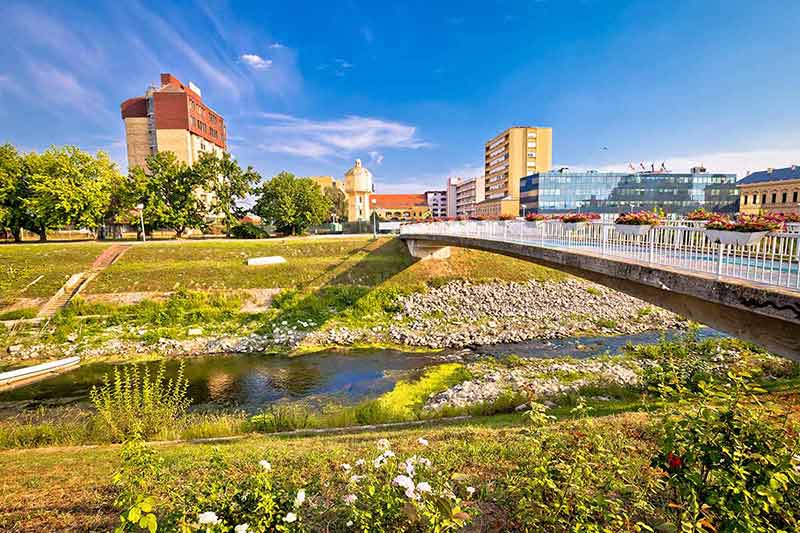
Vukovar is in eastern Croatia and is the largest river port in the country, It lies where the Vuka River and the Danube meet.
It is a significant city in the recent history of Croatia and a place to pay respects to all the Croatians who were killed in the Balkans War of 1991 – 1995.
It is where the largest massacre occurred since World War II.
Visit the Vukovar Municipal Museum to learn about this recent history.
To understand the damage the war caused, head to the Memorycalno Crobye Vukovar (the Memorial Cemetery).
Here you will see the many tombs of those who died during the war.
The Church of St. Philip & St. James was damaged during the war but beautifully restored in the town.
Inside, you will find photos of the church before the war.
Vukovar Hospital 1991 is now a museum.
It was here that in 1991, 88 patients were killed in the Vukovar massacre, a reminder of the futility of war.
- The Vukovar Museum is at Zuoanyska ul 2 32000
- The Church of St. Philip & St. James is at Samostanska ul 5 32000
- Vukovar Hospital is at Zupanyjska ul 35 32000
13- Sisek
Sisek is located on two river confluences and is 60 km (36 miles) from Zagreb.
It isn’t too touristy, so is a good city in Croatia to get away from the hubbub of cities such as Zagreb.
There is plenty to see in Sisek, such as the Sisek Fortress, built in the 16th century, is situated next to the Kupa Rover in the Old Town.
Here you will find a small museum and a good restaurant.
The City Museum is another place you should visit.
It houses artefacts from prehistoric times and the Roman occupation right through to the recent present.
Sisek sits on top of the Roman town of Siscia, and you can see remains of the granary, the walls, baths, and the tower.
The oldest brick building in the city dates to the 18th century and is called the Mali Kapitol.
Now, it is home to an exhibition, the Sisak Ring of History, depicting seven historical periods, and to the Siscia Jazz Club.
The City Museum is at ul Kalya Tomislava 10 44000
Mali Kapitol is at Rimiskaal 44000
14- Slavonski Brod
Slavonski Brod is a city in eastern Croatia near the border of Bosnia and Herzegovina and on the Seva Rover.
The Old Town is beautiful, with many Baroque buildings such as the churches of St Stefan and the Holy Trinity.
In the Franciscan Monastery, you will find a museum dedicated to the Croatian poet Drugutin Tadydnovic.
The fortress is worth a visit to see the casemates.
If you are lucky, you could be in the city when a cultural or historical event occurs at the fortress.
Slavonski Brod is an excellent base for hiking, trail running, or cycling, as there are plenty of trails.
The Slavonski Brod-Striborova Forest trail is 5.3 km (3.3 miles) long and is suitable for mountain biking or off-road driving.
15- Karlovac
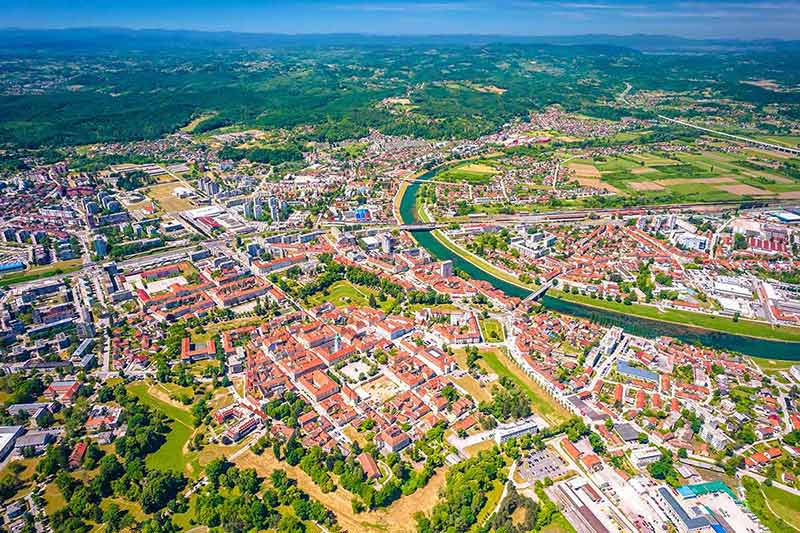
Karlovac is in central Croatia and has a lovely castle, Dubovac Castle, towering over the city on a hill.
You can walk there and luckily, there is a cafe/restaurant where you can replenish your thirst.
The castle, built in the Renaissance style in the 15th century, is well-preserved and has a museum inside.
As you can imagine, you will have lovely views over the city from the castle.
Museums in the city include the Franciscan Museum, which shows off the history of the Franciscan orders in the city with Baroque paintings and Franciscan sculptures.
Five minutes out of the city is the Museum of Army Collections, a strip of land with armoured vehicles from the Balkan war with artillery holes, a chilling reminder of the horrors of war.
The Aquatika Freshwater Aquarium is an interesting place to visit as few aquariums are dedicated to freshwater fauna.
All the fish are from Croatian rivers.
- Dubovac Castle is at Zagrad-Gaj ul 5 47000
- The Franciscan Museum is at ul Ivana Mazaranica 2 47000
- The Aquatika Freshwater Aquarium is at ul Branka Cavlov ica Caoleka la 47000
16- Poreč
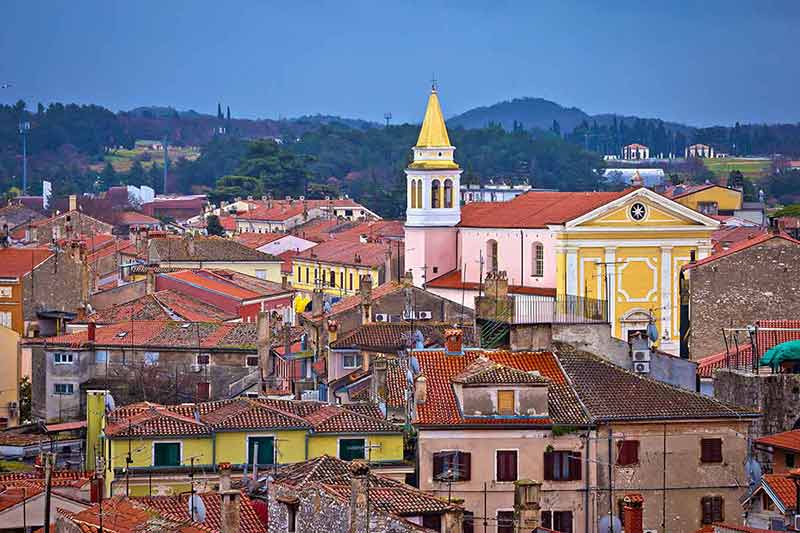
Poreč is a popular summer resort on the Istrian peninsula with a good balance of beaches, nightlife and history.
It is also a great place to go on a dolphin-watching boat ride.
The city has been inhabited for 20 centuries, and its heart is Marafor Square, where you can see pillars from temples dedicated to the ancient Roman gods and goddesses.
There are plenty of cafes and restaurants in the square where you can leisurely watch life go by.
The Euphrasian Basilica, dating back to the 16th century, has beautiful mosaics both inside and out and the facade has medallions of the Lamb of God and of 12 female martyrs.
For a family day out, head to Aquacolours Poreč, one of the largest waterparks in the country.
Among other attractions, it has 12 water slides, pools, a wave pool, a lazy river, a bouncing boxing ring, and plenty of fast-food restaurants.
- The Euphesian Basilica is at Eufrazijeva ul 22 52440
- Aquacolours Poreč is at Molindrio 18 52440
17- Cakovec
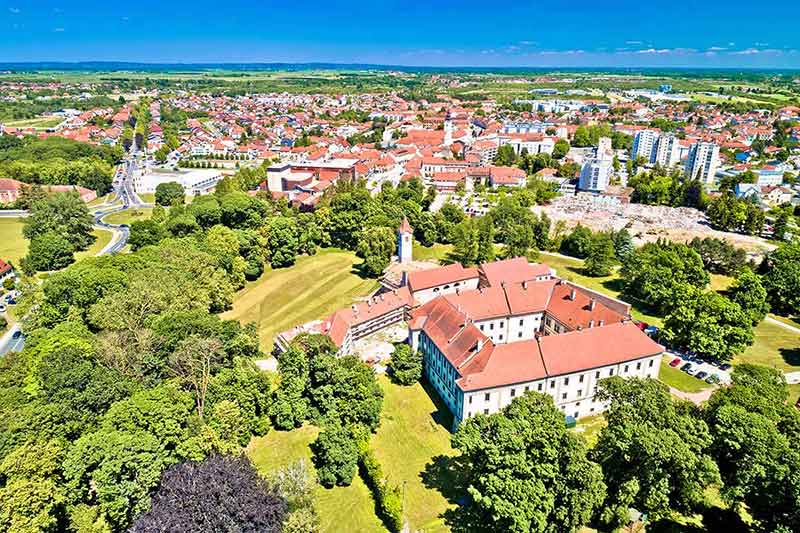
Cakovec is in northern Croatia, about 90 km (56 miles) from Zagreb.
The highlight is Cakovec Castle, also called Zrinskic Castle and is a mediaeval fortification in the middle of the city near the main square.
You will find the Museum of the Medzimurje Cakovec Region in the castle, with five different exhibitions: archaeology, ethnology, cultural history, history and an art gallery.
The most stunning building in this city is the Zgrada Doma Sindikata, built in the early 20th century in a Hungarian Secession style.
The outside is beautifully decorated at Christmas.
There are plenty of cafes on the same street and a park next door to relax in.
Cakovec Castle is at Trg Republike 5 40000
18- Bjelovar
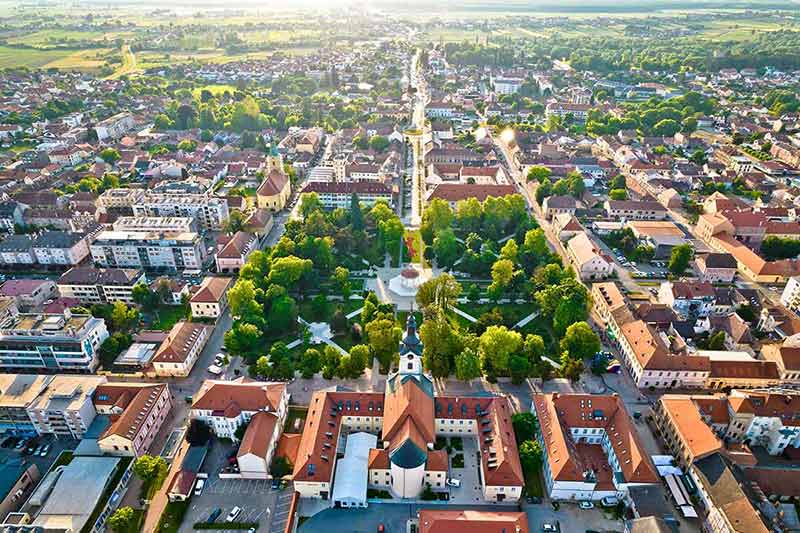
Bjelovar is a fortress city in the centre of Croatia famous for the smoked cheese, Bjelovarski Kvarg, one of the country’s delicacies.
At the city’s entrance, you will see a war memorial dedicated to the 11 Croatians who died during an explosion during the Balkans war.
Visit the Bjelovar City Museum, which houses a private art collection by local artists such as Edo Murtic.
The St Teresa of Avila Cathedral, built in the Baroque style, is another reminder of the recent war.
A grenade hit it and killed three worshippers.
A memorial plaque honours their memory.
The Bjelovar City Museum is at Trg Eugena Kvaternika 1 43000
19- Koprivnica
This is a smaller city off the tourist track 103 km (64 miles) from Zagreb and can be visited on a day trip.
Visit the Koprivnica City Museum, where you can learn about the city’s past.
A permanent exhibition showcases the city’s citizens’ creation, development and life since the 18th century.
There is also art on display, archaeological finds and information on how the city participated in the Balkans War.
The City Park, dating back to 1856, is a lovely place to wander in peace.
The park was designed by the famous Croatian gardener Drugutin Ruht.
There is a beautiful pavilion from 1896, designed by Antun Regina, and a famous sculpture, ‘The Awakening’, by Josef Fluksi.
There is an attractive artificial lake called Soderica Lake, where many Croatians spend their summer holidays.
Here you can walk around the lake and swim.
The City Museum is at Trg Leandra Brezovica 1 48000
20– Vincovci
Vincovci is a city in eastern Croatia, the oldest inhabited city in Europe.
People have lived here for over 8,000 years and it is the birthplace of the Roman Emperors Valentoruan and Valens.
The city’s heart is the main square, Trg Bana Josipa Sokcevica.
Here you will see some beautiful Baroque buildings and motifs of Orion, the oldest Indo-European Calendar.
There are plenty of cafes in the square where you can have a coffee and people-watch.
Next to the square is a lovely park with a monument dedicated to the Holy Trinity.
The most famous building is the Brad Property Agency which is photo-worthy and built in the Art Nouveau Style with towers and sloping roofs.
There are some lovely relief decorations above the entrance, symbolizing the meaning of forestry.
In the town’s centre is the Church of Saint Vincent Pallotti, the religious and cultural hub for the resident Roman Catholics.
It is a fairly new church, having been built in 1985 but it had to be restored when an artillery shell damaged it during the Balkan War.
The Church of Saint Vincent Pallotti is at Ulica Josipa Matasovica 32100.
For more cities in Europe, read:
- 20 Best Cities in Greece
- 20 Best Cities in Poland
- 20 Best Cities in Spain
- 20 Best Cities in Portugal
- 20 Best Cities in Turkey
- 20 Best Cities in Scotland
- 20 Best Cities in Italy
- 20 Best Cities in Ireland
- 20 Best Cities in Germany
- 20 Best Cities in Austria
- 20 Best Cities in Wales
- 20 Best Cities in Hungary
- 20 Best Cities in Serbia
- 20 Best Cities in Bulgaria
- 20 Best Cities in Slovakia
- 20 Best Danube River Cities
- 20 Best Cities in Romania
- 20 Best Cities in Finland
- 20 Best Cities in France
- 20 Best Cities in Switzerland
- 20 Best Cities in England
- 20 Best Cities in Iceland
- 20 Best Cities in Netherlands
- 20 Best Cities in Belgium
- 20 Best Cities at Night
- 20 Best Cities in Croatia
- 20 Best Cities in Denmark
- 20 Best Cities in Norway
- 20 Best Cities in Sweden
- 20 Best Cities in Slovenia
- 20 Best Cities in Latvia
Plan Your Trip

Rent A Car – Find the best car rental rates at Discover Cars. They compare car hire companies to provide you with the best deal right now.

Find A Hotel – If you’re curious about this article and are looking for somewhere to stay, take a look at these amazing hotels.

